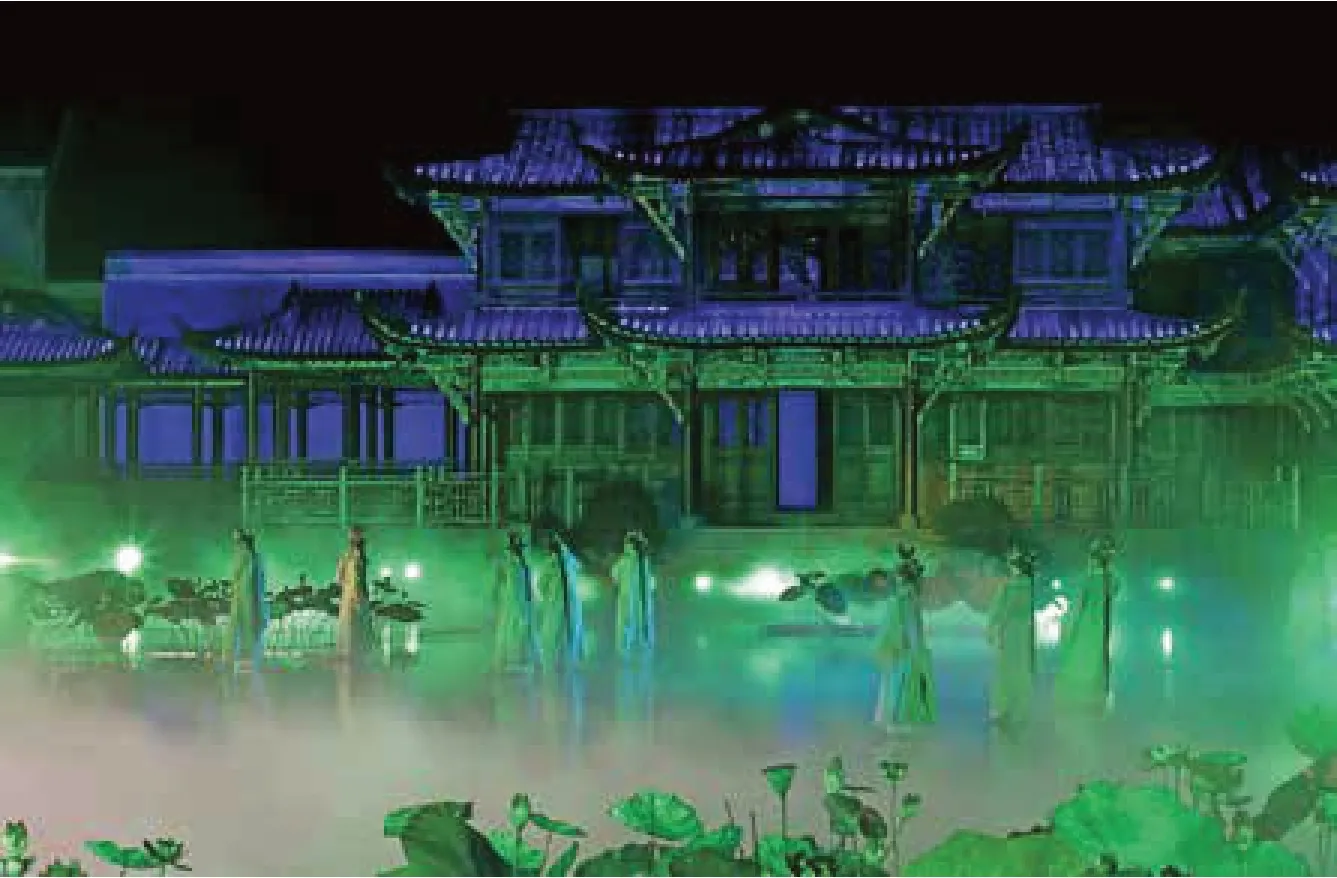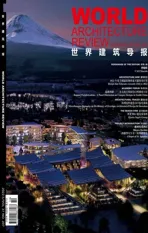江西抚州寻梦牡丹亭 中国江西
2022-11-16王冠,李欣叶,孙群等

业主:抚州市文化旅游投资发展有限责任公司
设计单位:中国建筑设计研究院有限公司
设计团队:王冠,李欣叶,孙群,范佳,刘倩,王嘉婧,孙超,王建武
用地面积:153 000 平方米
建筑面积:11 000 平方米
设计时间:2017年
竣工时间:2019年
Client: Fuzhou Cultural Tourism Investment Development Co.,Ltd
Architect: China Architectural Design and Research Group
Design team: Wang Guan,Li Xinye,Sun Qun,Fan Jia,Liu Qian,Wang Jiajing,Sun Chao,Wang Jianwu
Site Aera: 153,000 m2
Built: 11,000 m2
Design Date: 2017
Completion Date: 2019
设计与构思
“寻梦牡丹亭”实景演出文化公园选址于文学家汤显祖故乡江西抚州临川文昌里,总占地面积11 万平方米,从北至南由配套功能服务区、演出游园区以及历史保护街区三部分组成。该片区由于交通不便,成为城市发展中被边缘化的老旧城区,随着新兴小商业的发展,老旧建筑面临被拆除的困境。项目旨在活化传统戏剧,结合老旧街区改造,激活城市更新。
“千年汤显祖,寻梦牡丹亭”,长达500 米的三幕实景互动性演出,承载了建筑师对现实、地狱与天堂体验的极致想象。建筑师致力于将中国古典戏剧故事抽象为融传统造园和建筑于一体的意境空间,依托周边具有历史感的老屋旧宅,使现实梦境化、使梦境诗意化,创造出具有中国古典气质的真实乌托邦。项目作为规划建筑景观舞美一体化设计,巧妙诠释了新与旧、商业与文化、现实与幻想的融合,园区设计满足了“白天游园,夜晚观演”的复合化使用要求,提供了全天候的沉浸式表演与游园空间。
新建的演出游园区紧邻文昌里历史老街区,力求让修葺后的老宅能够承载部分文化配套功能,例如小型戏曲历史展览厅、公共休息厅、演员化妆室、商业零售等,将新的功能业态植入老街区,使之呈现出别样的更新发展方式,促进老旧街区的复兴与有机更新。
传统戏曲与老旧街区只有被活化利用才能长久存留,其文化价值也才能得以充分展现。抚州作为汤显祖创作《牡丹亭》的故地,项目不仅需要满足实景舞台布景的需要,更面临如何重拾文化遗珠,在建筑学语境下重新演绎百年《牡丹亭》戏剧灵魂的责任。
园区规划充分尊重场地现状,将保留鱼塘开挖扩大为水深3米的人工湖,舞美设计团队铺设水下演员行走栈道,整个湖面成为戏曲演出的水上主舞台。根据《牡丹亭》戏曲的故事内容,几百米的狭长场地被划分为“游园惊梦”“魂游寻梦”“三生圆梦”三个主题演出实景舞台。

一层平面图
Design Concept
The site of the "Dream of Peony Pavilion" live performance cultural park was chosen in Wenchangli,Linchuan,Fuzhou,Jiangxi Province,the hometown of the litterateur Tang Xianzu.the large-scale live performance park covers a total area of 110 000 square meters,and it is divided into three sections from the north to the south,namely the supporting Functional Service Area,Performance Park Area and Historical Protection Blocks.The area has become an old and marginalized part of the urban development due to its inconvenient traffic.With the development of new small businesses,the old buildings are facing the dilemma of being demolished.The project is designated to revitalize traditional theater,and activate urban regeneration in combination with old city renovation
“With Tang Xianzu a Thousand Years Ago,Seeking the Dream of Peony Pavilion".The 500-meterlong three-act interactive performance carries the architect's experience for the ultimate imagination of reality,hell and heaven.The architect is committed to abstracting the classical Chinese play into an imaginative space featuring "the traditional gardening and architecture”,relying on the surrounding old houses with a sense of history to dream the reality and poeticize the dream,creating a real utopia with classical Chinese temperament.As the design integrates planning architecture,landscape and stage art,the project skillfully interprets the fusion of new and old,business and culture,reality and fantasy,and the park is designed to have composite functions integrating night performance and daytime garden tour are both satisfied,providing an all-weather immersive performance and gardening tour space.
The new performance park area is adjacent to the old Wenchangli historical neighborhood,and seeks to enable the restored old mansion to accommodate some of the cultural supporting functions,such as a small theater history exhibition hall,public lounge,actors' dressing rooms,commercial retail,etc.with new functional formats implanted into the old neighborhood,so that it can present a different way of regeneration and development,and promotes the revival and organic regeneration of the old city.
Only when the traditional opera and old neighborhoods are revitalized and utilized can they survive for a long time,and their cultural value can be fully revealed.As the hometown of Tang Xianzu to create The Peony Pavilion,the project is not only to meet the needs of live stage sets,but also to shoulder the responsibility of regaining the cultural heritage and retranslating the soul of the century-old Peony Pavilion opera in an architectural context.

西立面图



北侧配套功能服务区总建筑面积1.1 万平米,包括游客接待中心、办公区及演员排练厅和员工宿舍等。为了与文昌里历史文化街区相互协调,建筑造型设计收放自如,融入传统“坡屋顶”与“合院”等抽象元素,并满足大空间的功能需求。整体建筑群通过连廊连接不同功能用房,充分考虑结合地方河道与局地小气候与风向,引入自然通风和采光,实现生态与节能。
戏曲讲究通过“起承转合”带动观众的情绪变化,这与中国传统造园的手法是一致的。通过深入研究剧本内容与情感,建筑师团队提炼出戏曲逻辑与园林布局逻辑的共通之处,演员们在建筑师精心布置的“场景”中穿梭:站在超出正常尺度的柱上舞蹈,在被切割过的“残亭”旁挥舞衣袖。建筑空间超越了功能本身,通过探究戏曲的抽象知觉与象征意义,达到观者情感与场所精神在一定程度上的统一。
材料与建构
建筑师不断思考《牡丹亭》每段主题所传达出的隐喻含义,并用材料与建构语言塑造了一个脱离于现世又具有现代意义的虚幻场景,如何打造服务戏剧的极致纯粹的“非真”空间是建筑师的极致追求。设计尝试通过对古建筑进行定向拓扑切割,通过对单一元素的堆叠塑造现实中不存在的极端空间来隐喻戏剧中虚幻的场景,传达出《牡丹亭》戏曲中“梦中之情,何必非真”的感受。
在戏剧第二幕“魂游寻梦”中,为了表现戏曲的冲突与矛盾,一些靠近水边的传统古建筑亭台被垂直切割,从屋顶每一片瓦到台梁到柱基,断面干净得仿佛被刀整齐裁切过。当观众观戏至此,看到某个建筑局部构件孤零零地在湖心岛的白沙滩上伫立,走进被整齐切割的亭台,将从内心深处感到脱离现实的不自然感。
The park planning fully respects the current situation of the site,the retained fish pond is expanded into a 3-meter deep artificial lake,the stage art design team laid underwater walking stacks for actors,making the entire lake the main stage of the opera performance on the water.According to the story of The Peony Pavilion,the narrow space of several hundred meters is divided into three themed live performance stages: "Sweet Dream in the Garden","Soul Traveling for Dream" and "Dream Realization in Three Lifetime".
The supporting functional service area on the north side has a total construction area of 11 000 square meters,including the visitor reception hall,office area and rehearsal hall for actors and staff dormitory,etc.To harmonize with the Wenchangli historical and cultural neighborhood,the building is designed to be flexible in style,incorporating abstract elements such as the traditional "sloping roof"and "courtyard",satisfying the functional requirements of large spaces.The overall building complex connects different functional rooms through corridors,fully considering the combination of local riverway and local microclimate and wind direction,fully introducing natural ventilation and lighting,and the design of the building complex realizes the purpose of ecology and energy saving.
Opera is concerned with driving the audience's emotional changes through the "introduction,elucidation of the theme,transition to another viewpoint and summing up",which is consistent with traditional Chinese gardening techniques.By studying the story and emotion of the play,the architects' team refined the commonality between the logic of the opera and the garden layout,and the actors moved through the "scenes" carefully arranged by the architects: dancing on columns beyond the normal scale,waving their sleeves next to the cut "ruined pavilion".The architectural space transcends function itself and achieves unity between the audience's emotions and the spirit of the place by exploring the abstract perception and symbolic meaning of opera.
Material and Construction
The architects continuously thought about the metaphorical meaning conveyed by each theme of The Peony Pavilion and used the language of construction and materials to shape an illusory scene that is detached from the present world and has modern significance.It is the architect's ultimate pursuit to create the ultimate pure "non-real" space to serve the theater and drama.The design attempts to metaphorize the illusory scenes in the drama by making directional topological cuts to the ancient buildings and shaping extreme spaces that do not exist in reality through the stacking of single elements,conveying the feeling that "why the love in a dream can't be not true" in The Peony Pavilion opera.




南立面图

内景与外景
游客接待中心紧邻老宅修缮区,建筑造型简洁而现代,原有老建筑砖墙立面与售票大厅主入口的玻璃幕墙形成视觉对比,混凝土的外墙更好地衬托了江南民居的白墙青瓦,新旧体量完美融合,设计手法实现了新旧建筑的对话。随着实景演出旅游吸引力的不断提升,新旧结合的游客服务区将有机会作为最真实的生活舞台,吸引游客探寻抚州当地的文化,同时也将使当地居民的文化生活与经济水平得以提升。
与普通固定座位的观赏方式不同,游客需要随着戏剧演出的情节推进,跟随舞台的切换在游览中进行动态的观戏,这种步移景异的观赏方法是中国古典园林所特有的游览方式,也给观众带来了一种身临其境的戏剧融入感。观戏流线中,游人行走在园中,通过空间的收放变化,以及灯光明暗、高低起伏、虚实遮挡、音乐强弱等变化,使观众得以亲身体验错综曲折的剧情。
隔河相望的观演座位与台地景观相结合,观众可席地而坐,台地采用修葺拆除的数千片旧瓦铺砌而成,在平地上搭建了一处类似传统瓦屋顶的观戏平台,台阶依次错落,在不同高度容纳更多人观戏,抽离于现实,取“屋顶观戏”之意。同时,水边悬挑的平台、直伸入水面的古亭、游走的长廊等都成为观戏的地点,与白墙灰瓦的屋檐呼应,唤起了墙头看戏的体验与古老记忆。
In the second act of the play,"Soul Traveling for Dream",in order to express the conflicts and contradictions of the opera,some of the traditional ancient pavilions near the water's edge were cut vertically,from every tile on the roof to the beams and pillar bases,the sections were as clean as if they were neatly cut by a knife.When the audience watch the play here and see some partial building component standing alone on the white sandy beach of the midlake island and walking into the neatly cut pavilion,they will feel the unnatural feeling of detachment from reality from deep inside.
Inside and Outside
The visitor reception hall is adjacent to the old mansion restoration area,where the building is simple and modern in style,the original old building’s brick façade contrasts visually with the glass curtain wall at the main entrance of the ticket office,the concrete façade better sets off the white walls and gray tiles of the dwellings in the regions south of the Yangtze River,the new and old volumes are perfectly integrated to dialogue between old and new buildings through the design approach.As the tourism appeal resulting from the live performance continues to grow,the combined old and new visitor service area will have the opportunity to serve as the most authentic living stage to attract visitors to explore the local culture of Fuzhou,and will also improve the cultural life and economy of the local aboriginal people.

Different from the ordinary fixed-seat viewing method,visitors need to follow the switching stage in the tour with the advancement of the plot of the drama performance for dynamic theater viewing,which is unique to classical Chinese gardens and gives the audience a sense of immersive theatrical integration.Following the plot of the drama performance,visitors walk in the garden,through the changes in space as well as changes in light and dark,ups and downs,virtual and real shading,music intensity and others,so that the audience can personally experience the intricate plot.
The seats across the river are combined with the landscape of the stage,where the audience can sit on the ground.The stage is made of thousands of old tiles that were repaired and demolished,and a platform similar to the traditional tile roof was built on the flat ground,with steps staggered to accommodate more people at different heights,which is detached from reality and takes the meaning of "viewing the play on the rooftop".Meanwhile,the overhanging platform at the water's edge,the ancient pavilion reaching straight into the water,and the wandering promenade have all become places for play watching,echoing the white-washed roofs and evoking the experience and ancient memories of watching the play on the wall.




